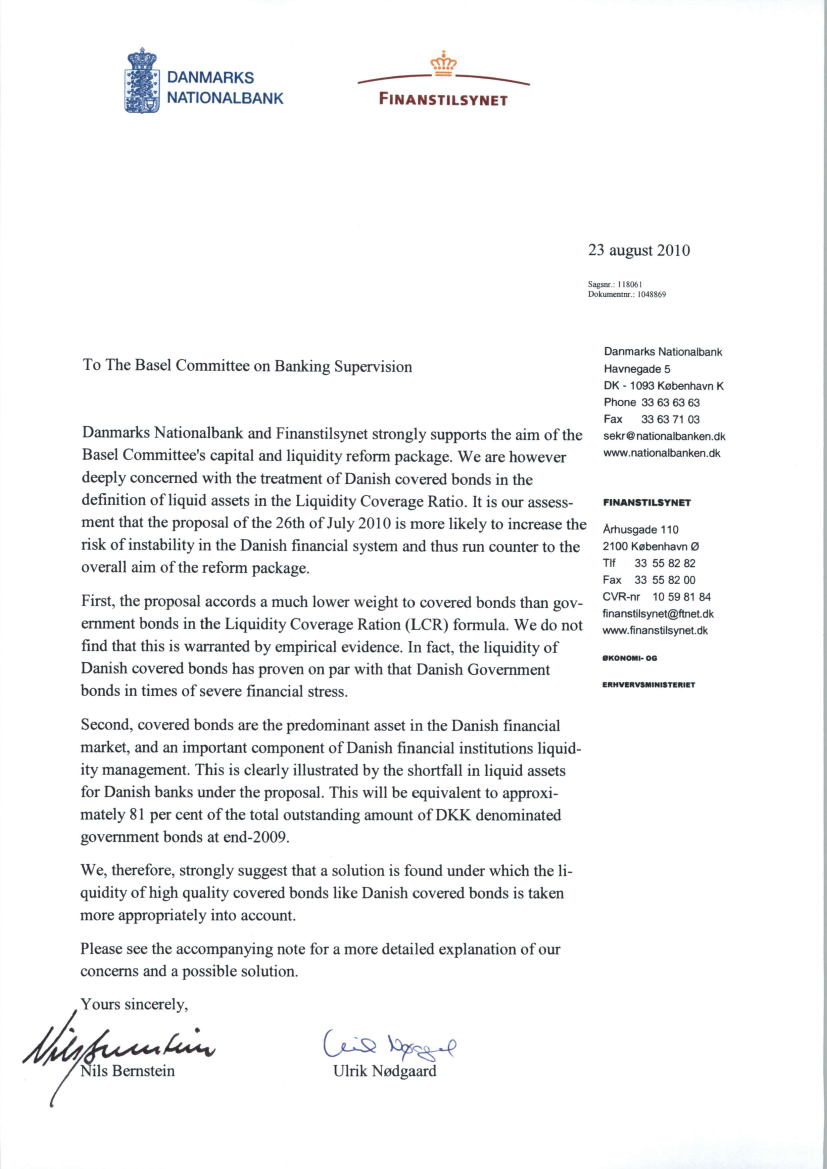
DANMARKS
NATIONALBANK
FINANSTILSYNET
23
august
2010
Sagsar
118061
Dokumentar
:
1048869
Danmarks
Nationalbank
To
The Basel
Committee
on
Banking
Supervision
Havnegade
5
DK
Fax
-
1093 København
K
Phone
33
63 63
63
33 63
71
03
Danmarks
Nationalbank
Basel
Committee's
and
Finanstilsynet strongly
supports the
aim
of
the
capital
and liquidity
reform
package.
We
are
howeveT
www.nationalbanken.dk
deeply
concerned
with
the
treatment
of Danish
covered
bonds
in
the
definition
of liquid
assets
in
the
Liquidity Coverage
Ratio.
It
is
our
assess-
that
the proposal of
the
26th
of July 2010 is
more
likely
to
increase the
risk
of
instability
in
the Danish
financial
system
and
thus
run
counter
to
the
ment
FINANSTILSYNET
Arhusgade
110
2100 København
Tlf
Fax
Ø
overall
aim
of
the
reform
package.
33 55
82
82
33
55
82 00
10
59 81 84
First,
the
proposal
accords
a
much lower
weight
to
covered
bonds than
gov-
bonds
in
the
Liquidity
Coverage
Ration
(LCR)
formula.
We
do
not
ernment
CVR-nr
www.finanstilsynet.dk
SMONOMI-
OG
find
that this is
warranted
by empirical evidence.
In
fact,
the
liquidity
of
Danish covered
bonds
has
proven
on
par
with
that
Danish
Government
bonds
in
times
of
severe
financial
.
ERHVERVSMINtSTERIET
stress.
Second, covered
bonds
are
market, and
an
important
ity
management.
This
is clearly illustrated
by
the
shortfall
in
liquid
assets
for
Danish
banks
under
the
proposal.
This
will
be
equivalent
to
approxi-
mately
8
1
per
cent
of
the
total
outstanding
amount
of
DKK
denominated
government
the
predominant
asset
in
the Danish
financial
component
of Danish financial institutions liquid-
bonds
at
end-2009.
suggest that
a
solution
is
found
under
which
the
li-
quidity of high quality covered
bonds
like
Danish
covered bonds is
taken
more
appropriately into
account.
Please
concerns
see
We,
therefore,
strongly
the
accompanying
and
a
note
for
a
more
detailed
explanation
of
our
possible
solution.
Yours
sincere
ils
Bernstein
Ulrik Nødgaard